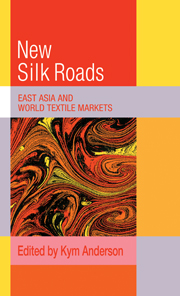Book contents
- Frontmatter
- Contents
- List of figures
- List of tables
- Contributors to this volume
- Preface
- Abbreviations and acronyms
- Symbols
- Introduction and summary
- I FIBRES, TEXTILES AND ECONOMIC DEVELOPMENT
- 1 The changing role of fibres, textiles and clothing as economies grow
- 2 The experience of Japan in historical and international perspective
- 3 Effects of China's dramatic reforms on its neighbours and on world markets
- 4 Thailand's growth in textile and clothing exports
- II DEMAND FOR TEXTILE EXPORTS FROM NEWLY INDUSTRIALIZING ASIA
- III CONCLUSIONS
- Appendix: Data on world production, consumption and trade in textiles, clothing and fibres
- Bibliography
- Index
4 - Thailand's growth in textile and clothing exports
Published online by Cambridge University Press: 19 January 2010
- Frontmatter
- Contents
- List of figures
- List of tables
- Contributors to this volume
- Preface
- Abbreviations and acronyms
- Symbols
- Introduction and summary
- I FIBRES, TEXTILES AND ECONOMIC DEVELOPMENT
- 1 The changing role of fibres, textiles and clothing as economies grow
- 2 The experience of Japan in historical and international perspective
- 3 Effects of China's dramatic reforms on its neighbours and on world markets
- 4 Thailand's growth in textile and clothing exports
- II DEMAND FOR TEXTILE EXPORTS FROM NEWLY INDUSTRIALIZING ASIA
- III CONCLUSIONS
- Appendix: Data on world production, consumption and trade in textiles, clothing and fibres
- Bibliography
- Index
Summary
The textile and clothing industry in Thailand has become particularly important to the Thai economy in recent years. Exports of its output have grown so rapidly that in the mid-1980s they became the country's highest foreign exchange earning commodity group. They contributed about one-quarter of manufacturing value-added and had the highest employment share of any sub-sector in the manufacturing sector. In 1988 exports of textiles and clothing amounted to US$2.4 billion (one-seventh of all exports) compared with $0.6 billion in 1983, with clothing exports alone valued at $1.9 billion in 1988. This rapid increase in the importance of textile and clothing production and exports suggests that Thailand is following the pattern of earlier industrial development of first Japan and then Hong Kong, the Republic of Korea and Taiwan.
This chapter has two main objectives: to explain why this subsector of manufacturing has grown so fast in Thailand, and then to analyse the effects of the Multi-fibre Arrangement (MFA) on the Thai clothing sector. The first two sections of the chapter provide some background on the development of Thai manufacturing in general and the growth of textile and clothing production and exports in particular. The government's role in the industry is then examined, and is followed by an analysis of the effect of the MFA. In the final section is a summary of conclusions and a discussion of Thailand's export prospects for the 1990s.
Growth and structural change in the Thai economy
Thai economy Thailand has enjoyed having one of the fastest-growing economies in the world since 1960, surpassed only by the East Asian NIEs.
- Type
- Chapter
- Information
- The New Silk RoadsEast Asia and World Textile Markets, pp. 52 - 68Publisher: Cambridge University PressPrint publication year: 1992



